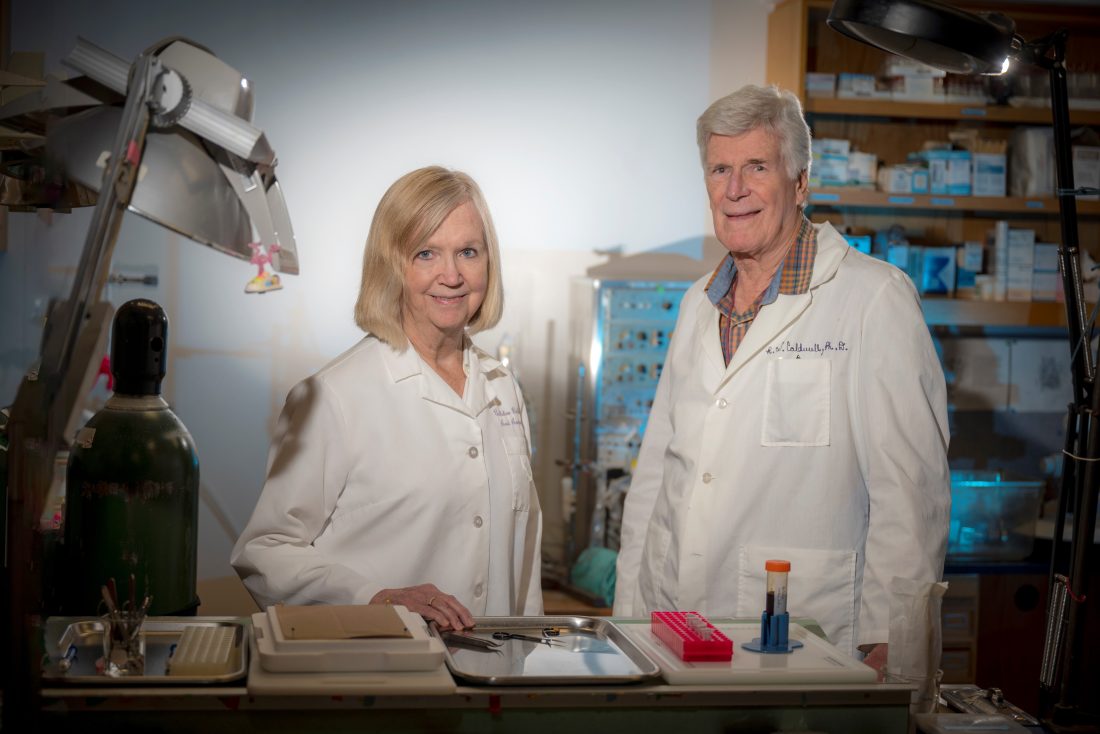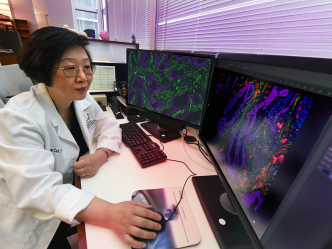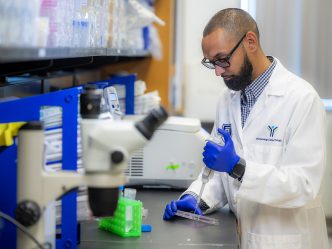An enzyme under study to treat certain cancers is also showing promise in reducing the significant vision damage that can result from diabetes and premature birth, scientists report.
Inflammation is considered a hallmark of cancer. It’s pervasive as well in both of these potentially blinding eye conditions, in which inadequate oxygen to the eyes prompts growth of new blood vessels to better deliver oxygen, but which instead often obstruct the vision pathway and become leaky, which causes swelling, further hindering vision.
Scientists at the Medical College of Georgia report in newly published studies in the journals Cell Death and Disease and Cells, increasing evidence that making more of the enzyme arginase 1, or A1, available helps alleviate these unhealthy responses and interrupt a natural body response that promotes destructive ongoing, high levels of inflammation in both diabetic retinopathy and retinopathy of prematurity.
Key to the process is making less of the amino acid L-arginine available. With diabetes, for example, high blood sugar and lipid levels as well as oxidative stress increase expression of inducible nitric oxide synthase, or iNOS, which uses the L-arginine to help produce even more inflammation and promote disease progression. The way it’s supposed to work is iNOS goes up in response to an infection then high-expressing A1 cells move in to turn iNOS off and inflammation down.
That’s because A1 competes with iNOS for L-arginine. They theorized that more A1, which actually breaks down L-arginine into two products, would make less L-arginine available to “feed this (unhealthy) iNOS explosion,” and help tamp down the vicious cycle of inflammation and related damage, says William Caldwell, PhD, pharmacologist and chair emeritus of the MCG Department of Pharmacology and Toxicology.
“If you reduce L-arginine levels, iNOS cannot work. This will make things better,” Caldwell says.
As a great example about how everything in the body is about balance, the powerful blood vessel dilator NO, or nitric oxide, which iNOS makes, is good for blood vessels and blood pressure when it is produced at low levels by the endothelial cells that line blood vessels. This NO has the added benefit of being anti-inflammatory. But the “toxic” high levels produced by iNOS result in production of more reactive oxygen species, which feeds inflammation, which basically “rusts” whatever tissue it touches, Caldwell says.
They found that when a diabetic, obese mouse that eats constantly and develops a condition similar to early stage diabetic retinopathy is given A1 three times a week for two weeks, it improves their visual acuity and enables the rodents to better distinguish degrees of darkness, like shades of grey.
The mice had less oxidative stress and inflammation in the retina, restoration of the protective blood retinal barrier to help avoid leakage of tiny capillaries and the swelling and damage that would follow, and reduced progression of diabetic retinopathy, says Ruth B. Caldwell, PhD, cell biologist in the MCG Vascular Biology Center.
Conversely, they have shown that mice which express only half the usual amount of A1 have more abnormal blood vessel growth and retinal injury, they write. William Caldwell notes that when A1 is completely eliminated, mice and people will die of ammonia poisoning because another important ongoing job of A1 is constantly working in the liver to help eliminate ammonia, which is produced when proteins, a basic building block of the body, are broken down.
That’s how A1 occupies so much L-arginine, which it cleaves or cuts to form urea, a form of ammonia which can be eliminated in the urine, and l-ornithine, which is important to normal physiological functions like cell proliferation and collagen formation.
The MCG scientists also have shown that A1 is naturally present in the immune cells and retinal cells of mice with oxygen-induced retinopathy, a common model for the destructive blood vessel growth that occurs in retinopathy of prematurity. The model also is used to mimic some aspects of diabetic retinopathy because diabetic mice don’t live long enough to develop full-blown eye disease. They’ve also found A1 present in the retinas of humans with diabetic retinopathy and in blood samples of young patients with retinopathy of prematurity.
AI’s anti-inflammatory power is exhibited in the way it can keep those immune cells, called macrophages, which can both promote and reduce inflammation, from becoming too proinflammatory, Ruth Caldwell says.
She notes that numerous antioxidants and other anti-inflammatory agents have been tried and failed to help patients with these conditions. “What we think is happening is this pegylated A1 is reducing within these immune cells the ability to make inducible nitric oxide synthase in big amounts. We think that is the deal.”
A1 normally breaks down in a matter of minutes, so like with studies in cancer, which also cannot grow and survive without L-arginine, they used a manmade pegylated, or stable, form that instead stays around for days.
New, accessible therapies are needed to help avoid the vision consequence of both type 1 and 2 diabetes as well as retinopathy of prematurity, the Caldwells say. Their studies indicate that in diseases where the blood retinal barrier is broken, A1 can penetrate the eye making shots directly into the eye unnecessary, which should make treatment much more accessible, the scientists say. Anti-VEGF (vascular endothelial growth factor) therapy, for example, used to also combat the growth of abnormal and leaky blood vessels, requires injections into the back of the eye.
The Caldwells are co-corresponding authors on the two new papers. Abdelrahman Y. Fouda, PhD, Ruth Caldwell’s former postdoctoral fellow who is now on the faculty of the University of Arkansas for Medical Sciences College of Medicine, is first author on the Cell Death and Disease paper. Ammar A. Abdelrahman, PhD, a postdoc in William Caldwell’s lab, is first author on the Cells paper.
The scientific team has already shown that administering pegylated A1 improves protection in ischemia/reperfusion injury, when oxygen supply is lost for a limited time, like with a knife injury, then the blood supply gets restored; in major optic nerve trauma; and following an ischemic stroke, by far the most common stroke type where a clot typically cuts off the blood and oxygen supply to a part of the brain.
The research projects were supported by the National Eye Institute, the James and Jean Culver Vision Discovery Institute at Augusta University and the Department of Veterans Affairs.
Read the studies here and here.
 Augusta University
Augusta University





